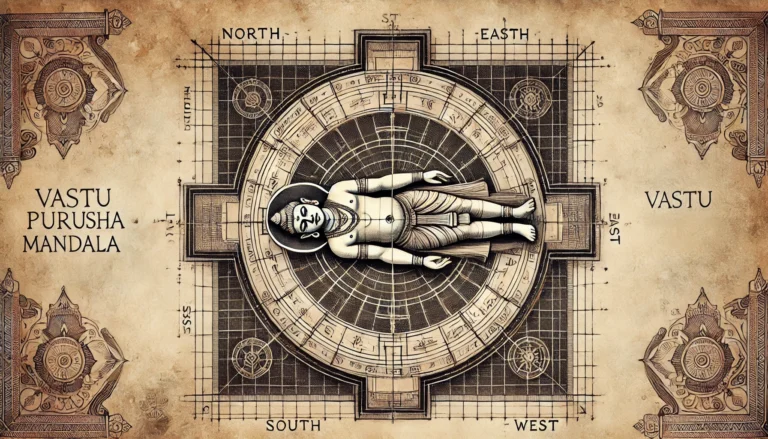Vastu Shastra is an ancient Indian science of architecture and design that aims to create harmony between humans and their surroundings. It is based on natural forces, directions, and energy flow to enhance well-being, prosperity, and success. In this article, we will explore the fundamental concepts of Vastu Shastra, its rules, principles, scientific relevance, and essential tips for a Vastu-compliant home.
Table of Contents
What is Vastu Shastra?
Vastu Shastra is a traditional Indian architectural system that combines science, art, astronomy, and astrology. The term “Vastu” means dwelling, and “Shastra” refers to knowledge or science. It provides guidelines for designing homes, offices, temples, and other structures to align with nature’s forces and cosmic energies.
Who Created and Invented Vastu Shastra?
The origins of Vastu Shastra date back over 5,000 years and are attributed to ancient sages like Vishwakarma and Mayasura. The knowledge was passed down through Vedic texts, particularly in books like Matsya Purana and Brihat Samhita.
What Does Vastu Shastra Involve?
Vastu Shastra covers various aspects of construction, including:
- Selection of land
- Placement of rooms, doors, and windows
- Use of materials
- Positioning of furniture
- Aligning the house with cosmic energies
What Are the Five Elements of Vastu?
Vastu Shastra is based on the balance of five elements, known as Panchabhutas:
- Earth (Prithvi) – Stability and support
- Water (Jal) – Flow of energy and emotions
- Fire (Agni) – Energy and transformation
- Air (Vayu) – Movement and freshness
- Space (Aakash) – Expansion and connectivity
Each element influences a specific direction and plays a vital role in maintaining harmony within a structure.
What Are the 8 Directions in Vastu?
Vastu divides space into eight cardinal directions, each associated with specific energies and deities:
- North (Kubera) – Wealth and prosperity
- South (Yama) – Strength and stability
- East (Indra) – Growth and health
- West (Varuna) – Gains and relationships
- Northeast (Ishanya) – Spirituality and wisdom
- Northwest (Vayu) – Communication and business
- Southeast (Agni) – Energy and power
- Southwest (Nairutya) – Stability and longevity
Each direction has unique attributes and influences various aspects of life.
What Is Vastu Purush?
Vastu Purush is the cosmic spirit or energy that governs architectural design according to Vastu Shastra. It is believed that Vastu Purush lies within every plot of land, and his body is aligned with different directions:
- Head in the Northeast – Represents wisdom and spirituality
- Feet in the Southwest – Symbolizes stability and grounding
- Right side in the Southeast – Associated with fire and energy
- Left side in the Northwest – Governs movement and communication
The concept of Vastu Purush helps in determining the ideal placement of rooms and structures to ensure a balanced and positive energy flow.
What Are the Rules of Vastu Shastra?
Vastu Shastra follows specific rules to ensure positive energy flow:
- The main entrance should face east or north.
- The kitchen should be in the southeast direction.
- The bedroom should be in the southwest for stability.
- Avoid constructing toilets in the northeast.
- Heavy furniture should be placed in the southwest corner.
Which Vastu is Good for Home?
A home that follows Vastu principles brings peace and prosperity. The ideal Vastu for a home includes:
- An entrance in the north or east.
- A well-lit and clutter-free northeast corner.
- A bedroom in the southwest for better relationships.
- A puja room in the northeast.
- Balanced placement of the five elements.
What Are the Five Essential Vastu Tips for Home?
- Keep the Entrance Clean and Well-Lit – It attracts positive energy.
- Avoid a Mirror in Front of the Bed – It can cause health issues.
- Place a Money Plant in the North – It enhances financial stability.
- Avoid Clutter in the Northeast – It ensures mental peace.
- Use Light Colors for Walls – It creates a calm and happy environment.
Can We Ignore Vastu?
While following Vastu is a personal choice, many believe it significantly impacts life. Ignoring Vastu may lead to stress, financial problems, or health issues. Even small adjustments can bring positive changes.
Is Vastu Shastra Really Important for Living?
Vastu Shastra helps in creating a balanced and harmonious environment. It enhances health, wealth, and relationships by optimizing space and energy flow. People who follow Vastu principles often experience positive changes in their lives.
Is Vastu Shastra Scientifically Proven?
Vastu Shastra is based on logical and scientific principles, such as:
- Proper ventilation for air circulation.
- Sunlight exposure for health benefits.
- Room placement for efficient energy use.
Though modern science does not fully validate all aspects, many Vastu principles align with architectural and environmental psychology concepts.
Recommended Books on Vastu Shastra
For a deeper understanding, here are some authoritative books on Vastu Shastra:
- Aapka Ghar Vastu Shastra Anusar – P.K. Sharma
- The Fundamentals of Vastu Shastra – Dr. Kunal Kaushik
- Vastu Shastra for a Healthy and Prosperous Life – A. R. Hari
- Maya’s Architecture: Vastu Shastra – D. N. Shukla
- Vastu: The Indian Art of Placement – Rohit Arya
Conclusion
Vastu Shastra is a blend of science, tradition, and spirituality that helps in designing a balanced and positive living space. By following Vastu principles, one can enhance health, wealth, and overall well-being. Whether you are constructing a new house or making minor adjustments, integrating Vastu practices can bring harmony to your home and life.
For those looking to explore further, investing time in learning from authoritative books and Vastu experts can be beneficial.
read also : हिंदू धर्म के 18 महा पुराण : इनमें क्या है और इन्हें किसने लिखा? | 18 Maha Puranas of Hinduism.
